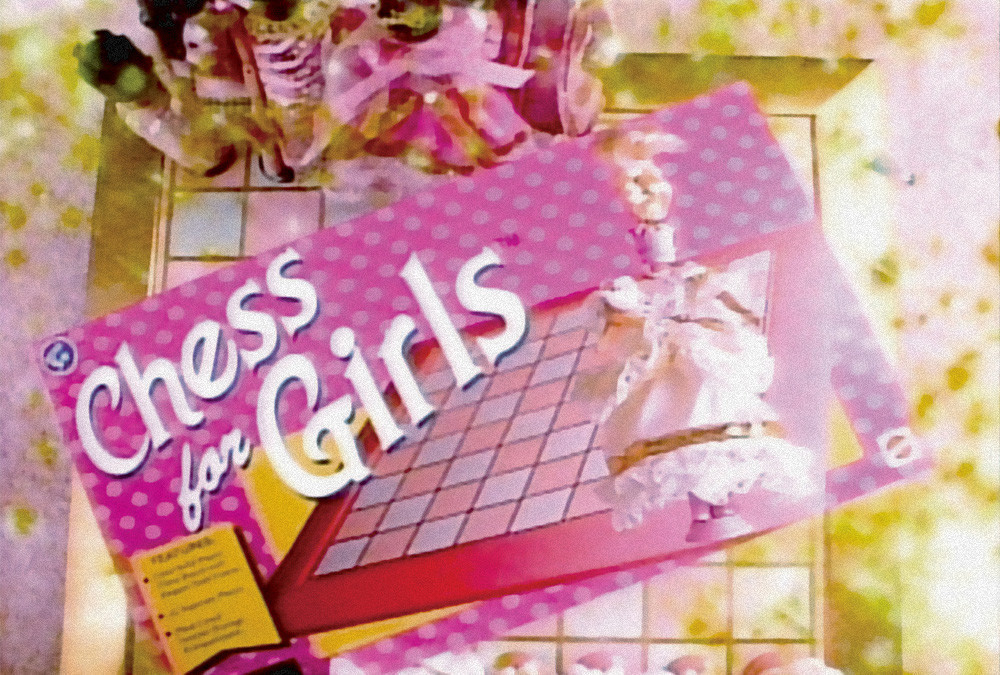Rebecca Strang

On December 6, 1997, Saturday Night Live showed aparody commercial for the game of chess. The commercial announces that chess is no longer a game for boys and now features Barbie-like pieces with decorative clothes that smell like strawberries and can be used to play house. The game claims to be “not too hard, just pretty and fun.” A full transcript of the parody is available here.
Today’s annotated bibliography comes from the first chapter of From Barbie to Mortal Kombat: Gender and Computer Games, “Chess for Girls? Feminism and Computer Games,” and is written by Justine Cassell and Henry Jenkins. The chapter digs into issues surrounding gender in gaming and getting girls into an arena that has traditionally been run by (and marketed toward) boys.
A parody about making chess for girls might seem absurd to us now while a serious call to action for getting girls into computer games has been gaining momentum because chess has been around long enough for parents to be comfortable with it and computers, though seemingly commonplace in most households today, are still blazing a new frontier. “Consequently,” say Cassell and Jenkins, “our children are more likely than us to see the computer as an essential part of their lives, and we are less likely than our children to be entirely comfortable with the technology.” If parents are not comfortable with computers, they are less likely to see the benefits of them and less likely to foster an interest in computers at home.
Further, computers have historically been defined as masculine and therefore a thing for boys (Cassell and Jenkins p4-10). Culturally, this has had an effect on the access and experience that girls have with computers. Cassell and Jenkins also discuss boys and girls think about what a computer is in different terms: “Boys are more likely to play games, to program, and to see the computer as a playful recreational toy. Girls tend to view the computer as a tool, a means to accomplish a task, such as word processing or other clerical duties (Ogletree and Williams 1990; Culley 1993).”
One of the biggest deterrents keeping girls away from video games is a lack of positive representations of women in video games. Violent games without a positive representation of women have continued to dominate the field. “Mortal Kombat,” “Street Fighter,” “Quake,” and “Duke Nuke’m” were popular at the time the chapter was written, and today we see popularity with games like “Grand Theft Auto.”
Cassell and Jenkins say that the features that will dominate the girls’ game movement include “more character-centered plots, issues of friendship and social relationships, and bright colorful graphics.” The challenge is getting games that will break into mainstream sales so that stores will want to showcase them.
The other challenge is making sure that while creating games that girls will like we are not simply regurgitating the current cultural stereotypes of what girls like into games. Games for girls should not only be pink, frilly, princess games. The focus should be on making games that both boys and girls will like that feature mechanics accessible to everyone. As Cassell and Jenkins say, feminism “has been historically committed to transforming rather than simply responding to existing gender roles.” Instead of creating a girls’ aisle of games and a boys aisle of games, create an aisle of games that call out to everyone.
This topic is highly relevant to things going on in retail stores today. In 2012, Dr. Rebecca Hains wrote an article about how stores are beginning to remove gender from the toy aisle. She referenced the same Saturday Night Live chess parody and discussed how some stores in London were beginning to organize toys byinterest instead of by gender. With the same goal, Target announced this year that it will be removing gender-based signage from its stores. From the Target announcement:
Historically, guests have told us that sometimes—for example, when shopping for someone they don’t know well—signs that sort by brand, age or gender help them get ideas and find things faster. But we know that shopping preferences and needs change and, as guests have pointed out, in some departments like Toys, Home or Entertainment, suggesting products by gender is unnecessary.
What are your thoughts on gender and gaming? More posts to come on this topic!
—————-
Cassell, J., & Jenkins, H. (1998). Chess for girls? feminism and computer games. In J. Cassell, & H. Jenkins (Eds.), From barbie to mortal kombat: Gender and computer games (pp. 2-45) The MIT Press.

